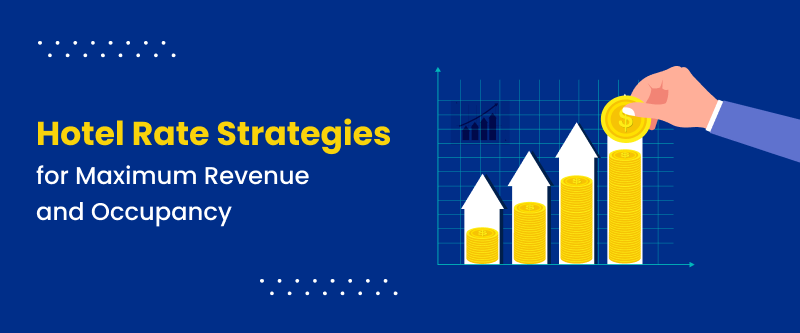Running a hotel is a complex and balancing act: you want to ensure all your rooms are booked and your guests are happy, but how do you set the right prices to make this happen?
Well, that’s where “hotel rate types” come into play. They act as the secret ingredient that can help you achieve this fine balance of setting the right price at the right time.
Think of rate types as unique pricing strategies tailored to different scenarios and guest segments. They’re like your toolkit for welcoming all sorts of guests, whether it’s during the bustling peak season or the quieter off-season.
If you’re new to the hotel business or a seasoned pro, understanding these rate types can make a huge difference in your hotel’s financial performance.
In this blog, we’ll break down the various hotel rate types, and how they can benefit your business and provide actionable strategies for you to maximize your revenue and occupancy.
So, let’s dive in!
Table of Content
- What are hotel rate types?
- Standard Rates
- Non-Refundable Rates
- Advance Purchase Rates
- Last-Minute Rates
- Package Rates
- Corporate Rates
- Group Rates
- Member or Loyalty Program Rates
- Benefits of Using Various Hotel Rate Types
- Catering to Varied Guest Preferences
- Boost Occupancy During Off-Peak Times
- Enhance Guest Experience
- Compete Effectively
- Ensure Long-Term Viability
- How to Use Different Hotel Rate Types to Maximize Revenue and Occupancy?
- Using Automated Tools & Software to Implement Various Rate Types
What are hotel rate types?
rate types are designed to cater to different guest preferences, needs, and booking behaviours. Each rate type comes with its own set of rules, restrictions, and benefits.
Here are some common hotel rate types:
- Standard Rates: These are the regular rates offered by hotels. They usually come with flexible booking and cancellation policies, allowing guests to make changes or cancel reservations without incurring significant penalties.
- Non-Refundable Rates: Non-refundable rates are typically lower than standard rates but come with stricter cancellation policies. Guests who choose these rates commit to their reservations and do not receive refunds if they cancel or modify their bookings.
- Advance Purchase Rates: Hotels offer discounts to guests who book their rooms well in advance. These rates encourage early booking and help hotels secure reservations ahead of time.
- Last-Minute Rates: Usually, last-minute rates are discounts offered to guests who book rooms on short notice. They are designed to fill vacant rooms that might otherwise go unsold.
- Package Rates: Package rates bundle room reservations with additional amenities or services, such as breakfast, spa treatments, or tickets to local attractions. These packages provide added value for guests.
- Corporate Rates: Hotels often negotiate special rates with businesses for their employees who travel for work. These rates are typically available to corporate clients and their employees.
- Group Rates: Group rates are tailored for parties booking multiple rooms, such as wedding groups, tour groups, or conference attendees. They often come with specific terms and conditions, including a minimum number of rooms to qualify for the discount.
- Member or Loyalty Program Rates: Many hotel chains have loyalty programs that offer exclusive rates and perks to their members. These rates can include discounts, room upgrades, and late check-out.
Each rate type serves a specific purpose, catering to different guest segments and booking behaviours. Hoteliers can strategically use these rate types to optimize their revenue and occupancy levels, while guests choose the rate type that best suits their travel plans and budget.
Benefits of Using Various Hotel Rate Types
First, let’s delve into the numerous advantages of using various hotel rate types, shedding light on how they not only maximize revenue but also enhance the overall guest experience:
- Catering to Varied Guest Preferences:
Different travellers have varying needs and budgets, and by offering a range of rate types, you can cater to these diverse preferences. Standard rates may appeal to cost-conscious guests, while package deals can entice those seeking value-added experiences. Corporate rates, in turn, cater to business travellers. This diversity ensures that your hotel remains an attractive option for various guest segments, ultimately leading to increased occupancy.
- Boost Occupancy During Off-Peak Times:
Using different rate types can significantly impact your revenue. Through strategic pricing, you can optimize revenue during peak seasons by offering higher rates, and fill rooms during off-peak periods by providing special promotions.
- Enhance Guest Experience:
Package rates that club room reservations with amenities or services such as dining vouchers or spa treatments can enhance the overall guest experience. Guests often appreciate the convenience and value of having everything they need included in one package.
- Compete Effectively:
Having a range of rate types can set your hotel apart from the competition. In a highly competitive market, this flexibility allows you to be agile and responsive to changes in guest preferences and market dynamics. Being able to offer unique deals or negotiate corporate rates with local businesses can give you a significant edge over rivals in your area.
- Ensure Long-Term Viability:
Diversifying rate types often leads to guest loyalty and repeat business. When guests find rate types that match their needs and preferences, they’re more likely to become loyal customers. This loyalty can translate into repeat bookings and referrals, reducing your reliance on costly marketing efforts and increasing the lifetime value of each guest.
How to Use Different Hotel Rate Types to Maximize Revenue and Occupancy?
Maximizing revenue and occupancy in a hotel involves the strategic use of various rate types effectively. So, let’s break down how you can use different hotel rate types to earn more and fill up your hotel rooms.
Start by figuring out the kinds of people who might want to stay at your hotel. Each group of people has different likes and dislikes, as well as how much they can spend. Make sure your prices match what these different groups of people want. Reduce rates during low-demand periods to attract budget-conscious travellers and raise rates during high-demand periods to maximize revenue.
Understand your property’s booking patterns, trends, and guest preferences. Based on that you can adjust your property’s rates accordingly. You can also leverage seasonal promotions and flash sales to generate buzz and boost occupancy during specific periods.
Hoteliers can also encourage guest loyalty by offering exclusive rates and perks through membership or loyalty programs. Offering competitive group rates and accommodating large bookings can fill rooms during low-demand periods. Thus, different rate types can be adjusted accordingly to maximize your occupancy and drive revenue throughout the season.
Using Automated Tools & Software to Implement Various Rate Types
A revenue management system (RMS) is a software application that can help you optimize your pricing strategies. RMSs can track demand, forecast occupancy, and set rates automatically.
An automated revenue management system empowers hotels to make data-driven decisions, adjusting rates dynamically based on real-time factors such as demand, competitor pricing, and historical booking patterns.
These systems optimize revenue and occupancy by automatically adjusting rates across various rate types. Moreover, reservation management platforms enable hotels to offer a wide range of rate options online, making it easier for guests to find and book the rates that best suit their needs.
A well-implemented revenue management system can be a game-changer for your hotel, automating your complex pricing decisions and ensuring that the right rates are offered to the right guests at the right time.
“ eZee Mint is one such smart and user-friendly revenue management software that applies intelligent pricing strategies.”
Conclusion:
Hotel rate types are powerful tools that can significantly impact a property’s both revenue and occupancy. By strategically using these rate types, hoteliers can adapt to market conditions, attract various guest segments, and maximize revenue throughout the year.
Remember, to succeed in this ever-changing world of hotels, it’s important to use data and be flexible in your approach. So, as you continue on your journey in hotel management, think of these rate types not just as tools, but as flexible ways to meet the needs of your guests and achieve your business goals.
By becoming skilled at using different rate types effectively, you’ll discover that you can not only increase the number of guests staying at your hotel and boost your revenue, but you can also make sure your guests have great experiences.



